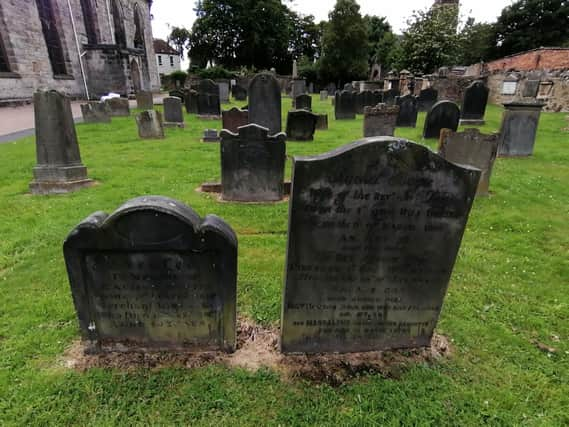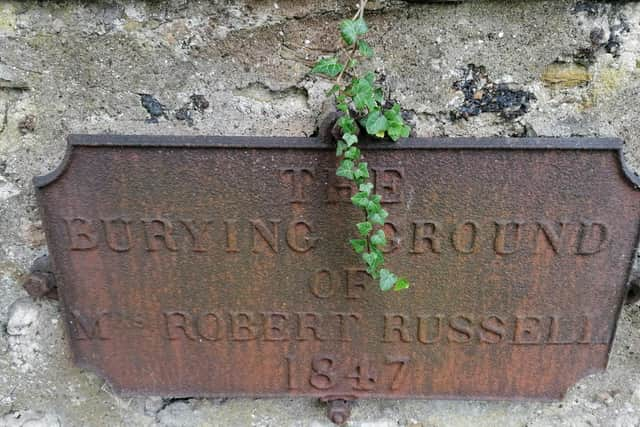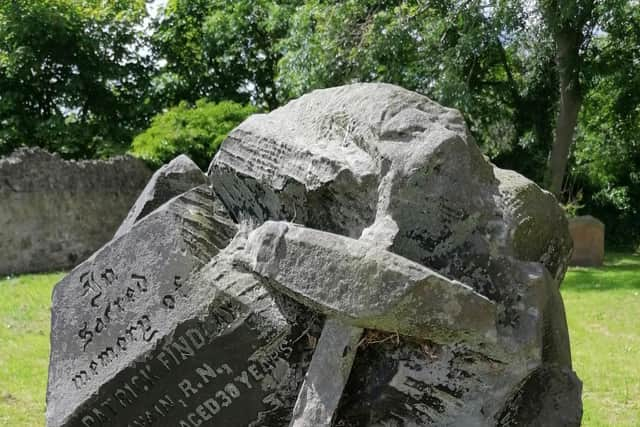Every headstone in our cemeteries has a story to tell...


Every headstone in a cemetery tells a story. The inscriptions not only record people’s lives, but give a glimpse into our town’s history.
The great and the good lie next to the ordinary working man, and children who barely made it beyond infancy.
Advertisement
Hide AdAdvertisement
Hide AdMen killed in war are buried alongside the mothers who mourned their premature deaths. In death, they bring our past to life.


One of the benefits of lockdown has been having the time to explore what is on our doorsteps – and cemeteries are fascinating places to learn about the place we call home.
Abbotshall and the Old Kirk have many historic graves, while Nether Street is an often overlooked gem when it comes to colouring in the picture of the past.
The size of the headstone may denote wealth and stature, but the details on it are of more importance.
Advertisement
Hide AdAdvertisement
Hide AdMen are defined by their trade. Women are defined solely by the trade of their husbands. Other than being married and raising children, they are afforded no footprint.


The number of ship owners underlines Kirkcaldy’s past role as a busy, and important port on the Forth, while linen features strongly on many grand headstones.
The dates recorded suggest the paths of many of these pillars of the community may have crossed, possibly socially, certainly in business.
Ship owners Robert Tod and Thomas Berwick died within a decade of each other – Berwick’s gravestone also records the loss of his grandchild, Jane, at seven weeks.
Advertisement
Hide AdAdvertisement
Hide AdOther ship owners buried at the Old Kirk include Michael Barker, who died in 1828.
The burial ground in Kirk Wynd is also the resting place of Thomas Millar, wood merchant, dead at 43 in 1869, and Robert Salmond, a confectioner from Kirkcaldy, who passed away in 1840.
That most slender of information confused images of a shop filled with treats and sweets; a place where perhaps generations of children were drawn?
And then there is David Black, a consulting brewer - a glimpse into a fascinating trade – who lays close to John Black, advocate and sheriff substitute, and Patrick Swan, merchant, deputy Lieutenant of Fife and Provost of Kirkcaldy for 30 years. He died, aged 81, in 1889.
Advertisement
Hide AdAdvertisement
Hide AdHis headstone was erected “in memory of his high personal character and eminent public service.”
At Nether Street, one of the most striking has to be the grave of Robert Kay, manufacturer, and his only son of John. He died “full of promise” on November 29, 1854. He was just five years and nine months old.
Another manufacturer, John Blyth of St Clairton – one of several different spellings of Sinclairtown to be found in the cemetery – passed away aged just 42 on February 15, 1855, a loss “regretted by all who knew him.”
You can only wonder if he too ever got over the death of his son, Alexander, in 1845 aged just three months, who shares his resting place.
Advertisement
Hide AdAdvertisement
Hide AdAt Abbotshall, there are more traders to be found – people who created the jobs, and generated the wealth which helped to build the foundations of this town
The detail on some of the graves helps to colour in the map of the past.
James Millar, baker, who died in 1873, hailed from Pathhead, while cabinet maker Samuel Barnet was from Sinclairtown, and Linktown was home to William Short, grocer (1865), and Alex Wilson, shipmaster (1880). Did they know of each other?
The graveyard is also the final resting place for “stone carver of this town” William Taylor, who died in 1811, and Alex Oram, wood carver, while James Black was a watchmaker from Kirkcaldy; a trade of great importance to gentlemen.
Advertisement
Hide AdAdvertisement
Hide AdThe most striking grave, however, is that of Robert Philp – one of the town’s eminent figures.
His headstone, which sits at the outer wall of the Old Kirk, celebrates his philanthropy, and reads like a balance sheet as it lays out, in detail, where his bequests went.
It notes that “by attention to business, integrity in dealing, he accumulated wealth, the most of which he destined to form a permanent capital, the proceeds whereof, to be applied in educating and clothing poor children and provide them with a sum of money.
This “laudable purpose” was recorded for posterity with donations to the parishes of Strathmiglo (£290,000), Collessie (£10,000), Kinghorn (£39,800), and heritable bonds at £700 giving a total of £70,700.
Advertisement
Hide AdAdvertisement
Hide AdIt is in striking contrast to the grave which simply states: RP-IB 1819, or the small headstones which simply state they are “the burying ground of” one man..”
Death brings together the great, the good and the humble working man.
Thank you for reading this story on our website. While I have your attention, I also have an important request to make of you.
In order for us to continue to provide high quality and trusted local news on this free-to-read site, I am asking you to also please purchase a copy of our newspapers - the Fife Free Press, Fife Herald, St Andrews Citizen and East Fife Mail.
Advertisement
Hide AdAdvertisement
Hide AdOur journalists are highly trained and our content is independently regulated by IPSO to some of the highest standards in the world. The dramatic events of 2020 are having a major impact on many of our local valued advertisers and consequently the advertising that we receive. We are now more reliant than ever on you helping us to provide you with news by buying a copy of our newspaper.
Thank you
Allan Crow, Editor, Fife Free Press